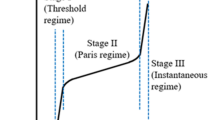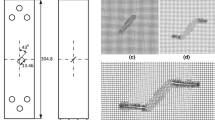Abstract
A prediction method for the propagation life of fatigue crack for cracked components was provided and verified in this study to predict the propagation life of fatigue cracks on components in engineering applications conveniently and directly. In the simulation aspect, a finite element (FE) model of cracked specimen was created to obtain the stress intensity factor range ΔK. The FE model was verified by comparing simulated ΔK to a formulary calculated one. The simulated ΔK could be used for studying the relationship with crack size. In the experimental aspect, the fatigue crack propagation test was conducted on three specimens. The material coefficients C and m were fitted according to Paris’ law. The load cycles with different crack depths were recorded in the testing process. The propagation life of fatigue cracks of specimen was predicted via the relationship between ΔK and crack size a according to Paris’ law. The comparison between predicted life and experimental life of specimens indicated the feasibility of the method. The proposed prediction method in this study for the propagation life of fatigue cracks can be used in engineering applications.
Similar content being viewed by others
References
P. Rubio, L. Rubio, B. Muñoz-Abella and L. Montero, Determination of the stress intensity factor of an elliptical breathing crack in a rotating shaft, International Journal of Fatigue, 77 (2015) 216–231.
L. J. Zhang, Y. R. Zhao and H. F. Xiang, Research of stress intensity factor of V-shaped notch tip in precision cropping, International Journal of Advanced Manufacturing Technology, 65 (1–4) (2013) 549–555.
Z. Jin and X. Wang, Weight functions for the determination of stress intensity factor and T-stress for semi-elliptical cracks in finite thickness plate, Fatigue & Fracture of Engineering Materials & Structures, 36 (10) (2013) 1051–1066.
H. Sanati, A. Amini, F. Reshadi, N. Soltani, G. Faraji and E. Zalnezhad, The stress intensity factors (SIFs) of cracked half-plane specimen in contact with semi-circular object, Theoretical and Applied Fracture Mechanics, 75 (2015) 104–112.
H. J. Shen and W. L. Guo, 3D constraint effect on 3D fatigue crack propagation, International Journal of Fatigue, 27 (6) (2005) 617–623.
Y. Yao, M. E. Fine and L. M. Keer, An energy approach to predict fatigue crack propagation in metals and alloys, International Journal of Fracture, 146 (3) (2007) 149–158.
D. V. Ramsamooj, Analytical prediction of fatigue crack propagation in metals, Journal of Engineering Mechanics, 129 (6) (2003) 672–682.
S. Deng, X. P. Qin and S. Huang, A study on the effect of subsurface crack propagation on rolling contact fatigue in a bearing ring, Journal of Mechanical Science and Technology, 29 (3) (2015) 1029–1038.
F. Ghanem, N. B. Fredj, H. Sidhom and C. Braham, Effects of finishing processes on the fatigue life improvements of electro-machined surfaces of tool steel, International Journal of Advanced Manufacturing Technology, 52 (5–8) (2011) 583–595.
L. Lazzeri and U. Mariani, Application of damage tolerance principles to the design of helicopters, International Journal of Fatigue, 31 (6) (2009) 1039–1045.
U. Zerbst, S. Beretta, G. Köhler, A. Lawton, M. Vormwald, H. Th. Beier, C. Klinger, I. Černý, J. Rudlin, T. Heckel and D. Klingbeil, Safe life and damage tolerance aspects of railway axles-A review, Engineering Fracture Mechanics, 98 (2013) 214–271.
V. L. Neelakantha, T. Jayaraju, P. Naik, K. D. Kumar, C. R. Rajashekar and Mohankumar, Determination of fracture toughness and fatigue crack growth rate using circumferentially cracked round bar specimens of Al2014T651, Aerospace Science and Technology, 47 (2015) 92–97.
G. M. Domínguez Almaraz, J. L. Ávila Ambriz and E. Cadenas Calderón, Fatigue endurance and crack propagation under rotating bending fatigue tests on aluminum alloy AISI 6063-T5 with controlled corrosion attack, Engineering Fracture Mechanics, 93 (2012) 119–131.
K. R. Gadelrab, M. Chiesa, M. Hecker and H. J. Engelmann, Modeling crack propagation for advanced 4-point bending testing of metal-dielectric thin film stacks, Engineering Fracture Mechanics, 96 (2012) 490–499.
Y. Kim, K. Lee and H. Li, Fatigue life prediction method for contact wire using maximum local stress, Journal of Mechanical Science and Technology, 29 (1) (2015) 67–70.
V. Tran, S. Geniaut, E. Galenne and I. Nistor, A modal analysis for computation of stress intensity factors under dynamic loading conditions at low frequency using extended finite element method, Engineering Fracture Mechanics, 98 (2013) 122–136.
C. S. Shin and C. Q. Cai, Experimental and finite element analyses on stress intensity factors of an elliptical surface crack in a circular shaft under tension and bending, International Journal of Fracture, 129 (2004) 239–264.
G. Meneghetti, C. Guzzella and B. Atzori, The peak stress method combined with 3D finite element models for fatigue assessment of toe and root cracking in steel welded joints subjected to axial or bending loading, Fatigue & Fracture of Engineering Materials & Structures, 37 (7) (2014) 722–739.
J. C. Passieux, J. Réthoré, A. Gravouil and M. C. Baietto, Local/global non-intrusive crack propagation simulation using a multigrid X-FEM solver, Computational Mechanics, 52 (6) (2013) 1381–1393.
J. Lebahn, H. Heyer and M. Sander, Numerical stress intensity factor calculation in flawed round bars validated by crack propagation tests, Engineering Fracture Mechanics, 108 (2013) 37–49.
M. Heyder and G. Kuhn, 3D fatigue crack propagation: Experimental studies, International Journal of Fatigue, 28 (5–6) (2006) 627–634.
C. Ni, L. Hua, X. K. Wang, Z. Wang, X. P. Qin and Z. Fang, Coupling method of magnetic memory and eddy current nondestructive testing for retired crankshafts, Journal of Mechanical Science and Technology, 30 (7) (2016) 3097–3104.
J. Toribio, F. J. Ayaso, B. González, J. C. Matos, D. Vergara and M. Lorenzo, Critical stress intensity factors in steel cracked wires, Materials & Design, 32 (8–9) (2011) 4424–4429.
Y. Peng, L. W. Tong, X. L. Zhao and Z. G. Xiao, Modified stress intensity factor equations for semi-elliptical surface cracks in finite thickness and width plates, Procedia Engineering, 14 (2011) 2601–2608.
Author information
Authors and Affiliations
Corresponding author
Additional information
Recommended by Associate Editor Yang Zheng
Chen Ni received her M.S. degree in Materials Processing Engineering from Wuhan University of Technology, China in 2012. She is currently a Ph.D. student of Wuhan University of Technology, China. Her current research interests include nondestructive testing and fatigue life evaluation.
Lin Hua received his M.S. degree in Pressure Processing from Wuhan University of Technology, China in 1985. He then received his Ph.D. degree in Mechanical Engineering from Xi’an Jiaotong University, China in 2000. Dr. Hua is currently a Professor at the School of Automotive Engineering at Wuhan University of Technology in Wuhan, China. He is also the Dean of the Hubei Key Laboratory of Advanced Technology for Automotive Components in China. His research interests include fatigue and nondestructive testing.
Rights and permissions
About this article
Cite this article
Ni, C., Hua, L., Wang, X. et al. Numerical and experimental method for the prediction of the propagation life of fatigue crack on metallic materials. J Mech Sci Technol 32, 4183–4190 (2018). https://doi.org/10.1007/s12206-018-0816-2
Received:
Revised:
Accepted:
Published:
Issue Date:
DOI: https://doi.org/10.1007/s12206-018-0816-2




